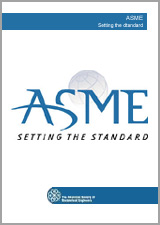We need your consent to use the individual data so that you can see information about your interests, among other things. Click "OK" to give your consent.

ASME PTC5:2011
Gas Turbine Inlet Air-Conditioning Equipment
Translate name
STANDARD published on 2012
The information about the standard:
Designation standards: ASME PTC5:2011
Publication date standards: 2012
SKU: NS-1226058
The number of pages: 138
Approximate weight : 445 g (0.98 lbs)
Country: American technical standard
Category: Technical standards ASME
Annotation of standard text ASME PTC5:2011 :
This Code provides procedures for in-situ testing of inlet air conditioning systems (cooling/heating) as they apply to gas turbines in simple, cogeneration, and combined-cycle applications. Specifically, the procedures may be used to determine the following performance variables, as applicable:
Performance Factor Carryover Auxiliary consumption (power/thermal) Temperature change Water discharge Water consumption Distribution/stratification Pressure drop This Code provides procedures for the calculation of the results, and for the correction of the results to reference conditions as a measure of gas turbine inlet air-conditioning systems performance.
Cooling systems covered by this Code include evaporative systems (foggers and media-based evaporative coolers) and mechanical/thermal refrigeration systems. Heating systems covered by this code include compressor-bleed type systems and heating-coils systems.
This Code contains rules and procedures for conducting and reporting tests of gas turbine inlet air-conditioning systems, including requirements for pretest arrangements, testing techniques, instrumentation, methods of measurement, and methods for calculating test results and uncertainty.
In planning and conducting the test, both a pre-test and post-test uncertainty analyses are required to accomplish testing with reasonable accuracy and in recognition of the fact that there is a diverse range of inlet conditioning system designs covered by this Code. Each unique system has corresponding uncertainty levels that are dependent on the system type, specific design complexity, and consistency of operation during a test, and cannot be generally categorized for purposes of establishing uncertainty limits on the test results achievable from testing in accordance with this Code. Uncertainty values for some typical systems are derived using the limiting uncertainties of all measurement parameters and variables.
We recommend:
Technical standards updating
Do you want to make sure you use only the valid technical standards?
We can offer you a solution which will provide you a monthly overview concerning the updating of standards which you use.
Would you like to know more? Look at this page.



 Cookies
Cookies
